The Underground Network: Arbuscular Mycorrhizal Fungi - Sebastian Jones
Introduction
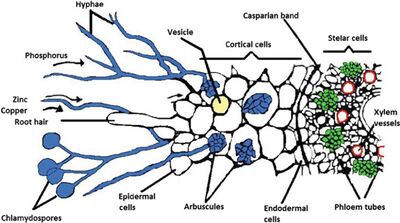
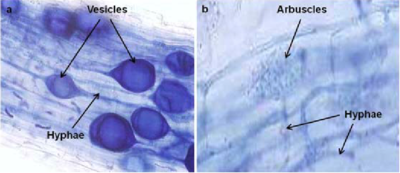
Arbuscular Mycorrhizal Fungi (AMF) are a symbiotic fungi that colonize plant roots and form a mutualistic relationship (Image 1). Over 70% of land plants have formed a symbiotic relationship with AMF.[3] They are identifiable by their unique structures vesicles, hyphae and arbuscles (Image 2). A vesicle is a small sac filled with liquid that can be used for storage and transport. Hyphae are small, tentacle-like, tubular projections that will form a complex network. An arbuscule is a site of nutrient exchange. Three of the most common types of mycorrhizal symbioses are, ectomycorrhizal, endomycorrhizal and ecto-endomycrorizha. AMF's are the second, endomycorrhizal. [4] Arbuscular Mycorrhizal Fungi play many roles in an ecosystem. One of the most important roles of the AMF is the transfer of Phosphorous and Carbon between it and the host plant. [3] In addition, they increase the resistance of their host to salinity and heavy metals [5] [6], droughts [7], and soil pathogens. [8] They have also been shown to contribute to enhanced soil; Increasing soil structure, particularly in agricultural settings and preventing the loss of important nutrients due to rainfall. [9]
History

The human history of understanding Arbuscular Mycorrhizal Fungi began in 1840 when Robert Hartig when he thought he was describing a root parasite, however, paleobotanical, morphological and phylogenetic data show that more than 400 million years, plants and AMF have coevolved. [11] Then in 1885, Albert Bernard Frank was the first to conceptualize it. Research has continued to this day with constant technological advances allowing new discoveries to be nearly constantly made. A recent important technological advancement was the advent of computer software that automatically quantifies the degree of AMF colonization of a plant root. The discovery was made by Cambridge's Sainsbury Laboratory and it is called AMFinder. It was developed with convolutional neural networks and it is able to accurately identify colonization in several plants commonly used in AMF research. [12]
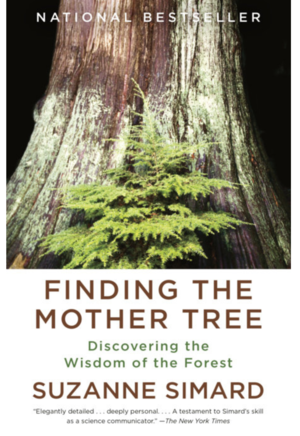
Arbuscular Mycorrhizal Fungi recently became mycological celebrities. In her book Finding the Mother Tree (Image 4) Dr. Suzanne Simard outlined the role of AMF in forests. She coined the term "Wood Wide Web" to describe the influence of AMF in connecting species within the forest. The book became a New York Times best seller and it won a variety of Canadian literary awards. However, she received some criticism from fellow biologists for a variety of reasons including her extensive use of anthropomorphic metaphors to describe plants and fungi. [14]
Genetics
As with the technology used to analyze AMF, there has also been considerable advancements in the understanding of AMF genetics. Using rice (Oryza sativa) as a model organism, researchers have studied the genes necessary for mycorrhizal formation. [16] The genes CASTOR, POLLUX, CCAMK (DMI3), and CYCLOPS were found to be critical for the formation of mycorrhiza in legumes and rice. [16] However, there were two groups types of genes found that are specific only to mycorrhiza formation. The first group is expressed early in development. It includes AM1-3 and AM11. The second group contains genes that are expressed later in development. [16] These genes are: AM10, 11, 14, 15, 18, 20, 24, 25, 26, 29, 31, 34, 39, 42 and PT11. Additionally, phosphate transport is hugely important to in the symbiotic relationship of plants and AMF, two plant phosphate transporters have been identified. Genes PT4 and PT3 in addition to contributing to phosphate transport are also believed to have a role in maintenance and life span of arbuscles. [17] Given that they are expressed in the arbuscle, these genes are thought to have a significant role in symbiosis. [17]
Genetic Material Exchange
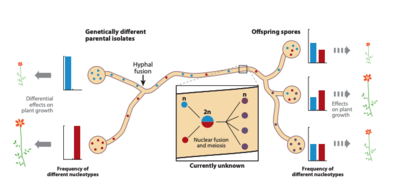
Another aspect of arbuscular mycorrhizal fungal genetics that is being researched but currently, not completely understood is the process of nuclear fusion and then meiosis between two genetically different parental AMF. The hyphal networks of two unrelated AMF can fuse together. This process is called hyphal fusion. Once this occurs, a form of genetic exchange is possible between the two different nuclei. This was proven in a lab setting when two hyphal networks were grown together. The two parental networks joined and after six months, new spore were able to colonize plant roots <br18>. When two parent nuclei join together, it is unknown whether the genetic exchange is caused by nuclear fusion, recombination or meiosis. [18] However the authors state that "This as a
priority for research on this symbiosis." [18] This process is depicted in Image 5.
Limitations to Our Understanding Arbuscular Mycorrhizal Fungal Genetics
As previously mentioned, the significant lack of knowledge of AMF genetics has significantly hindered overall research. There are a number of factors that have contributed to the lack of understand. The most significant is that AMF have long been believed to be asexual organisms. Mendelian methods for studying genetics have not been used to study AMF and this has significantly limited our understanding. In addition, AMF are difficult to study as they have to be grown on plants. This necessity adds significant complexity and a huge number of possible variables that could be overlooked and unknowingly lead to a misguided truth. Other reasons include the genome Organization, genetic variation and the population genetics of AMF. [18]
Mutualistic Relationship
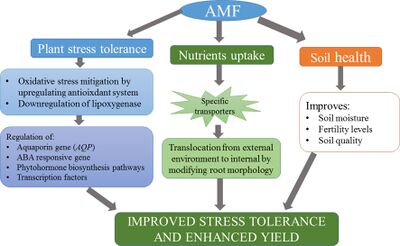
As mentioned in the introduction, Arbuscular Mycorrhizal Fungi colonize plant roots and then form a mutualistic relationship with the plant. Each organism uses it unique properties to provide a benefit that the other would likely not otherwise be able to receive.
Mutualistic Nutrient Exchange
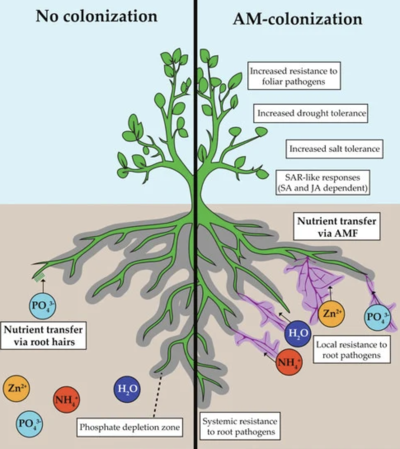
Host plants and Arbuscular Mycorrhizal Fungi are very different in their structures and abilities. Plants are larger with some parts above ground and other parts below. They have leaves, stems, chlorophyl and many other attributes that the AMF does not. Conversely, while it may seem like a disadvantage for the AMF to be smaller, their size and ability to create large colonial networks allows them to access parts of the soil that the host plant's root system is otherwise unable to. From these differences rises the core of the symbiotic relationship between AMF and their host, the exchange of carbon (C) and phosphorous (P). [3] Plants absorb carbon dioxide and through the carbon fixation cycle they transform it into carbohydrates. AMF do not have this same capability since they live below ground and do not have the same exposure to carbon as plants. The first part of the symbiotic relationship is, through the root colonization by AMF, the host plant will transfer between 4% and 20% of the their photosynthetic carbon to the AMF. [3] In addition to using the transferred carbon, the AMF will also act as a storage unit for the host plant, allowing it to have a greater carbohydrate reserve on hand. [3] When the carbon is transferred, it is the forms of hexose and fatty acids. [3]
There are typically two methods for a terrestrial plant to acquire minerals and nutrients from the soil: root pathways and AMF. [3] In order to complete the symbiotic relationship, Arbuscular Mycorrhizal Fungi transfer phosphorous from the soil to the plant. Phosphorus is most commonly found in the soil in the form of orthophosphates, H2PO4- and HPO4- Arbuscular Mycorrhizal Fungi's structures are better suited to seeking out phosphorous than a plants roots. The hyphal networks are often larger than a plants root system, allowing AMF to cover a larger area when looking for phosphorus. Additionally, the individual arms of the hyphae are smaller than that of a root. This allows them to travel through smaller pores in the soil. [21] [22] The increased phosphoric absorption by the host plant has been shown to contribute to increased growth. [23] This underscores the importance of the core element of the symbiotic relationship. However, phosphorus is not the only mineral transferred to the host. AMF have also been shown to uptake and transfer zinc (Zn), iron (Fe), copper (Cu), nitrogen (N), potassium (K), calcium (Ca) and magnesium (Mg). [23] It has been found that plants with the presence of AMF will frequently have higher levels of these elements. [23]
Cheating the Symbiosis and the Exchange
When the Arbuscular Mycorrhizal Fungi and the host plant are under certain conditions, the AMF has been shown to cheat the host plant by tricking it to supply carbon without sending any nutrients back. [24] Not only does this provide an even greater benefit to the AMF than normal since they continue to gain from receiving carbon without encountering any of the costs of transferring nutrients back, it has been shown to be very costly to the host plant. In some cases it has been linked to a decline in plant growth. [24] However, this relationship is very hard to prove and to investigate as AMF offer a large variety of benefits to the host plant and many can only be observed under certain conditions. [25] This is still an emerging area of research with new discoveries constantly being made.
Benefits to the Host Plant Beyond Nutrient Exchange
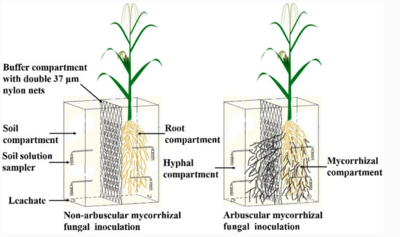
While the core of the symbiotic relationship is nutrient transfer, particularly phosphorous, there are countless other benefits for the host that go beyond this including: increased drought resistance and increased soil structure and the prevention of mineral leeching during rainfall. [9]
Increased Drought Resistance
Water is crucial to a plant's survival. Different plants may have different levels of natural tolerance for water deprivation, a complete lack of water will eventually kill any plant, just like any other living thing. There has been a significant amount of research that has shown that the mutualistic relationship between the host and AMF can increase the host's drought resistance. [21] There are several reasons that are thought to individual and/or collectively work to increase a plant's drought resistance. First, AMF increase the hydraulic conductivity of the host plant's roots. [21] [22] Hydraulic conductivity refers to how well a plant can move water through its roots, across gradients, to the xylem in the plant stem. Properties of AMF including the hyphal network are thought to increase the host plant's ability to effectively move water.
Second, it is believed that AMF can increase the host plant's ability to regulate its somata.[21] [22] The stomata are typically the underside of a plant's leaves although in some plants they are on the stem. They regulate the gas exchange in plants however when they open, evaporation leads to water loss. Stomata have to open during the day so that photosynthesis can occur but this means that they are open when the plant is most susceptible to water loss from evaporation due to the sunlight. Giving the plant a greater ability to control the stomata would lead to reduced water loss from evaporation. Many droughts, not all, occur in hot, arid climates. This underscores the importance of reducing water loss from evaporation.
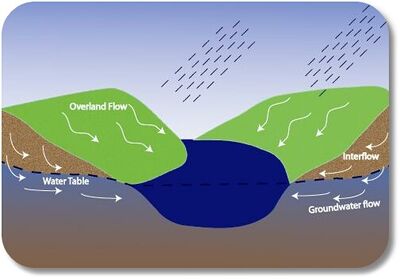
The third suggested reason to why Arbuscular Mycorrhizal Fungi provide increased drought resistance is that the hyphal network gives the plant's own root system a greater amount of contact with the soil. [21] [22] This is believed to allow plant's to extract greater amounts of water from the soil including from pores that would have otherwise been too small without AMF. [21] [22]
Increased Soil Structure and Reduced Loss of Soil Nutrients From Rainfall
As a component of the mutualistic relationship, the host plant will transfer up to 20% of its photosynthetic carbon to AMF. [3] This adds significant AMF biomass to the soil. Subsequently, AMF has been found to create macro-aggregates in the soil by binding the micro-aggregates. [27] This process increases the structure of the soil, and it has been shown that AMF can reduce the loss of minerals like phosphorous to the interflow and water leeching, particularly in heavy rainfall. [9] An experiment conducted by He et al (2021) found that in rainfall up to 80mm/hr there was a decrease of phosphorous of between 37% and 65% in the interflow (Image 9). They also found a decrease of 21%-39% in phosphorous leeching in rainfall between 40mm/hr and 80mm/hr. [27] Their experimental setup is shown in Image 8. Given the aforementioned observed benefits of phosphorous to plant growth, the decrease in phosphorous loss is incredibly beneficial to plant growth. AMF will not only reduce the amount of rainfall lost, but it also helps to protect the minerals necessary for plant growth, phosphorous.
Arbuscular Mycorrhizal Fungi in Farming
Just as other non-farmed plants develop mutualistic relationships with AMF, crops are able to interact in the same way. The combination of the symbiotic relationship of AMF and the host plant and the degree of human influence on crops and the farming method leads to an interesting interaction between Arbuscular Mycorrhizal Fungi and modern farming methods. Modern farming has a largely negative impact on AMF colonies. [28] [29]
The Effects of Fertilizer Usage on AMF
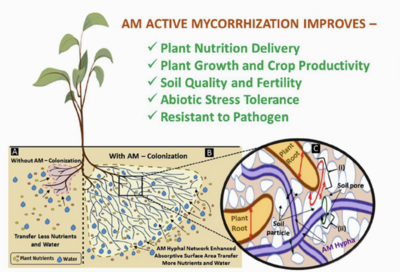
The presence of phosphorous has been shown to contribute to increased growth of the host plant when it is in a symbiotic relationship with Arbuscular Mycorrhizal Fungi. [31] This is one of the reasons why fertilizers contain phosphorous as it is known have a positive effect on a plant. In modern farming techniques, phosphoric fertilizers are used and frequently, their usage will exceed the crop requirements, leading to a build up of excess phosphorus in the soil that is readily available for the crop. [32] This leads to a disruption in the core pillar of the symbiotic relationship between the host and AMF since the host will not longer need to rely on AMF for phosphorous. Often times, this will reduce AMF colonization and AMF spore density. [31] Studies have shown that AMF colonization is greatest when phosphorous levels are low and lowest when phosphorous levels are high. [33] Nitrogen based fertilizers have been shown to effect Arbuscular Mycorrhizal Fungi in similar ways as phosphorous fertilizer. [34] Subsequently the use of fertilizers in modern farming, often leads to damaging or killing Arbuscular Mycorrhizal Fungal colonial networks.
The Effects of Tillage on AMF
In order to prepare a field for planting, a farmer will till their field. With modern farming techniques, this usually means pulling a mechanism behind a tractor and historically, a less complex device was pulled behind horses or oxen. When a field is tilled, the mycorrhizal networks are broken up and the Arbuscular Mycorrhizal Network can be severely damaged. [35] This can lead to the crop (host plant) absorbing less minerals and nutrients which often delays and/or reduces growth. [36] In certain cases, this can even lead to reduced crop yield. [37] Research has shown that un-tilled fields have the highest amounts of AMF colonization and spores. However, fields that were tilled with a mouldboard plough system had the most efficient phosphorus use. [38] These higher levels of AMF colonization have been shown to increase the amount of nutrient uptake in the crop (host plant).
The Effects of Organic Farming Methods on AMF
Organic farming has been around for centuries since it was the only way to farm prior to the industrial revolution. It has began to make a strong resurgence in the 21st century. One of the core principles of organic farming is avoiding the use of mineral fertilizers, one of the threats to Arbuscular Mycorrhizal Fungi. Without the use of fertilizers, the only was for plants to absorb the needed levels of phosphorus, they have to rely on biological process. It is therefore generally assumed that AMF can make up for the lack of fertilizer. [39] In organic farming systems, researchers have found greater degrees of AMF diversity. [39] Arbuscular Mycorrhizal Fungi in organic farming systems have been found to be just as effective as fertilizers at increasing the available phosphorous for the crop. [40] However, AMF does not necessarily increase the crop yield since the AMF may actually drain carbon from the plant, reducing its growth. [41]
References
- ↑ Kuila D, Ghosh S. Aspects, problems and utilization of arbuscular mycorrhizal (AM) application as bio-fertilizer in Sustainable Agriculture. Current Research in Microbial Sciences. 2022Jan;3:100107.
- ↑ Akhtar MS, Abdullah SN. Mass production techniques of arbuscular mycorrhizal fungi: Major advantages and disadvantages: A Review. Biosciences Biotechnology Research Asia. 2014Dec28;11(3):1199–204.
- ↑ 3.0 3.1 3.2 3.3 3.4 3.5 3.6 3.7 Zhang L, Zhou J, George TS, Limpens E, Feng G. Arbuscular mycorrhizal fungi conducting the hyphosphere bacterial orchestra. Trends in Plant Science. 2022Apr;27(4):402–11.
- ↑ Winagraski E, Kaschuk G, Monteiro PH, Auer CG, Higa AR. Diversity of arbuscular mycorrhizal fungi in forest ecosystems of Brazil: A Review. CERNE. 2019May20;25(1):25–35.
- ↑ Al-Karaki GN, Hammad R, Rusan M. Response of two tomato cultivars differing in salt tolerance to inoculation with mycorrhizal fungi under salt stress. Mycorrhiza. 2001Jan22;11(1):43–7.
- ↑ Shetty KG, Hetrick BAD, Schwab AP. Effects of mycorrhizae and fertilizer amendments on zinc tolerance of plants. Environmental Pollution. 1995;88(3):307–14.
- ↑ Aug RM, Duan X, Ebel RC, Stodola AJW. Nonhydraulic signalling of soil drying in mycorrhizal maize. Planta. 1994;193(1):74–82.
- ↑ Lingua G, Massa N, D'Agostino G, Antosiano M, Berta G. Mycorrhiza-induced differential response to a yellows disease in tomato. Mycorrhiza. 2002;12(4):191–8.
- ↑ 9.0 9.1 9.2 9.3 He Y, Yang R, Lei G, Li M, Li T, Zhan F, et al. Arbuscular mycorrhizal fungus–induced decrease in phosphorus loss due to leaching in red soils under simulated heavy rainfall. Journal of Soils and Sediments. 2021Jan7;21(2):881–9.
- ↑ Evangelisti E, Turner C, McDowell A, Shenhav L, Yunusov T, Gavrin A, et al. Deep learning‐based quantification of arbuscular mycorrhizal fungi in plant roots. New Phytologist. 2021Aug16;232(5):2207–19.
- ↑ Brundrett MC. Coevolution of roots and mycorrhizas of land plants. New Phytologist. 2002Apr30;154(2):275–304.
- ↑ Evangelisti E, Turner C, McDowell A, Shenhav L, Yunusov T, Gavrin A, et al. Deep learning‐based quantification of arbuscular mycorrhizal fungi in plant roots. New Phytologist. 2021Aug16;232(5):2207–19.
- ↑ Simard S. Finding the mother tree by Suzanne Simard: 9780525565994: Penguinrandomhouse.com: Books [Internet. PenguinRandomhouse.com. Knopf; [cited 2022Dec8]. Available from: https://www.penguinrandomhouse.com/books/602589/finding-the-mother-tree-by-suzanne-simard/]
- ↑ Inquisitivebiologist, Inquisitivebiologist, says: C. Book review – finding the mother tree: Uncovering the wisdom and intelligence of the Forest [Internet. The Inquisitive Biologist. 2022 [cited 2022Dec8]. Available from: https://inquisitivebiologist.com/2022/02/25/book-review-finding-the-mother-tree-uncovering-the-wisdom-and-intelligence-of-the-forest/]
- ↑ [link vancouver citation]
- ↑ 16.0 16.1 16.2 Gutjahr C, Banba M, Croset V, An K, Miyao A, An G, et al. Arbuscular mycorrhiza–specific signaling in rice transcends the common symbiosis signaling pathway. The Plant Cell. 2008Nov20;20(11):2989–3005.
- ↑ 17.0 17.1 [https://www.science.org/doi/full/10.1126/science.1146487 Drissner D, Kunze G, Callewaert N, Gehrig P, Tamasloukht MB, Boller T, et al. Lyso-phosphatidylcholine is a signal in the arbuscular mycorrhizal symbiosis. Science. 2007Oct12;318(5848):265–8. ]
- ↑ 18.0 18.1 18.2 18.3 Sanders IR, Croll D. Arbuscular Mycorrhiza: The challenge to understand the genetics of the fungal partner. Annual Review of Genetics. 2010;44(1):271–92
- ↑ Begum N, Qin C, Ahanger MA, Raza S, Khan MI, Ashraf M, et al. Role of arbuscular mycorrhizal fungi in plant growth regulation: Implications in abiotic stress tolerance. Frontiers in Plant Science. 2019Sep19;10.
- ↑ Jacott C, Murray J, Ridout C. Trade-offs in arbuscular mycorrhizal symbiosis: Disease resistance, growth responses and perspectives for Crop Breeding. Agronomy. 2017Nov16;7(4):75.
- ↑ 21.0 21.1 21.2 21.3 21.4 21.5 Augé RM. Water relations, drought and vesicular-arbuscular mycorrhizal symbiosis. Mycorrhiza. 2001May28;11(1):3–42.
- ↑ 22.0 22.1 22.2 22.3 22.4 Augé RM. Arbuscular mycorrhizae and soil/plant water relations. Canadian Journal of Soil Science. 2004Nov1;84(4):373–81.
- ↑ 23.0 23.1 23.2 VOSATKA M. Influence of inoculation with arbuscular mycorrhizal fungi on the growth and mycorrhizal infection of transplanted onion. Agriculture, Ecosystems & Environment. 1995Apr;53(2):151–9.
- ↑ 24.0 24.1 Lerat S, Lapointe L, Piché Y, Vierheilig H. Variable carbon-sink strength of different glomus mosseae strains colonizing Barley Roots. Canadian Journal of Botany. 2003Aug1;81(8):886–9.
- ↑ Vandenkoornhuyse P, Ridgway KP, Watson IJ, Fitter AH, Young JP. Co‐existing grass species have distinctive arbuscular mycorrhizal communities. Molecular Ecology. 2003Sep17;12(11):3085–95.
- ↑ Interflow [Internet. Groundwater dictionary. [cited 2022Dec8]. Available from: https://www.dws.gov.za/Groundwater/Groundwater_Dictionary/index.html?introduction_interflow.htm]
- ↑ 27.0 27.1 Tisdall JM, Smith SE, Rengasamy P. Aggregation of soil by fungal hyphae. Soil Research. 1997;35(1):55.
- ↑ Menéndez A, Scervino J, Godeas A. Arbuscular mycorrhizal populations associated with natural and cultivated vegetation on a site of Buenos Aires Province, Argentina. Biology and Fertility of Soils. 2001May;33(5):373–81.
- ↑ [https://www.nature.com/articles/28764 Helgason T, Daniell TJ, Husband R, Fitter AH, Young JP. Ploughing up the wood-wide web? Nature. 1998Jul30;394(6692):431–.
- ↑ [https://doi.org/10.1016/j.crmicr.2022.100107 Kuila D, Ghosh S. Aspects, problems and utilization of arbuscular mycorrhizal (AM) application as bio-fertilizer in Sustainable Agriculture. Current Research in Microbial Sciences. 2022;3:100107. ]
- ↑ 31.0 31.1 Jensen A, Jakobsen I. The occrrence of vesicular-arbuscular mycorrhiza in barley and wheat grown in some Danish soils with different fertilizer treatments. Plant and Soil. 1980Jun;55(3):403–14.
- ↑ Mallarino AP, Wittry DJ. On-farm implementation of the phosphorus index observed risk ratings and impacts on fertilizer and manure phosphorus management. Proceedings of the Integrated Crop Management Conference. 2004Dec2;
- ↑ Mårtensson AM, Carlgren K. Impact of phosphorus fertilization on VAM diaspores in two Swedish long-term field experiment. Agriculture, Ecosystems & Environment. 1994;47(4):327–34.
- ↑ Treseder KK, Allen MF. Direct nitrogen and phosphorus limitation of arbuscular mycorrhizal fungi: A model and field test. New Phytologist. 2002Aug20;155(3):507–15.
- ↑ Anderson EL, Millner PD, Kunishi HM. Maize root length density and mycorrhizal infection as influenced by tillage and soil phosphorus. Journal of Plant Nutrition. 1987Jun1;10(9):1349–56.
- ↑ EVANS DG, MILLER MH. Vesicular-arbuscular mycorrhizas and the soil-disturbance-induced reduction of nutrient absorption in maize. I. Causal relations. New Phytologist. 1988Sep;110(1):67–74.
- ↑ Kabir Z, O'Halloran IP, Hamel C. Combined effects of soil disturbance and fallowing on plant and fungal components of mycorrhizal corn (Zea mays L.). Soil Biology and Biochemistry. 1999Feb;31(2):307–14.
- ↑ Kabir Z, O'Halloran IP, Fyles JW, Hamel C. Dynamics of the mycorrhizal symbiosis of corn (Zea mays L.): Effects of host physiology, tillage practice and fertilization on spatial distribution of extra-radical mycorrhizal hyphae in the field. Agriculture, Ecosystems & Environment. 1998Mar;68(1-2):151–63.
- ↑ 39.0 39.1 Galvez L, Douds DD, Wagoner P. Tillage and farming system affect am fungus populations, mycorrhizal formation, and nutrient uptake by winter wheat in a high-P soil. American Journal of Alternative Agriculture. 2001Dec;16(4):152–60.
- ↑ [https://doi.org/10.1080/01448765.1998.9755219 Kahiluoto H, Vestberg M. The effect of arbuscular mycorrhiza on biomass production and phosphorus uptake from sparingly soluble sources by Leek (allium porrum l.) in Finnish field soils. Biological Agriculture & Horticulture. 1998;16(1):65–85.]
- ↑ Kahiluoto H, Ketoja E, Vestberg M, Saarela I. Plant and Soil. 2001;231(1):65–79.
Edited by [Sebastian Jones], student of Joan Slonczewski for BIOL 116 Information in Living Systems, 2022, Kenyon College.
